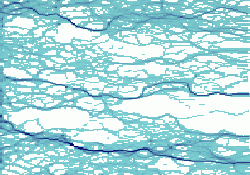
Superconducting vortices in random pinning
Ideal superconductors carry current without
resistance and perfectly expel externally applied magnetic
fields. The superconductivity is destroyed when too great
a magnetic field is applied, and the material becomes a
normal resistive conductor. Type-II materials remain
superconducting in high magnetic fields by allowing the
magnetic flux to penetrate the material in the form of
discrete quantized vortices which repel each other and
interact with defects in the superconducting material. The
superconducting material returns to its normal resistive
state only at the center of these vortices; the remainder
of the material still carries a supercurrent. The
vortices experience a Lorentz force from the flowing current
and move through the superconductor until they are trapped,
or pinned, at defect sites. Using molecular dynamics
simulations, we explore the microscopic dynamics of
vortices interacting with randomly arranged
pinning sites under many conditions.
Papers:
-
Using principal component analysis to distinguish different dynamic phases in superconducting vortex matter
C.J.O. Reichhardt, D. McDermott, and C. Reichhardt
Phys. Rev. B 111, 104508 (2025).
arXiv
-
Kibble-Zurek scenario and coarsening across nonequilibrium phase transitions in driven vortices and skyrmions
C. Reichhardt and C.J.O. Reichhardt
Phys. Rev. Res. 5, 033221 (2023).
arXiv
-
Kibble-Zurek mechanism for nonequilibrium phase transitions in driven
systems with quenched disorder
C.J.O. Reichhardt, A. del Campo, and C. Reichhardt
Commun. Phys. 5, 173 (2022).
arXiv
-
Jamming, fragility and pinning phenomena in superconducting vortex systems
C. Reichhardt and C.J.O. Reichhardt
Sci. Rep. 10, 11625 (2020).
arXiv
-
Devil's staircase and disordering transitions in sliding vortices and
Wigner crystals on random substrates with transverse driving
C. Reichhardt and C.J. Olson Reichhardt
Phys. Rev. B 76, 214305 (2007). arXiv
-
Probing vortex systems with individual vortex manipulation
C.J. Olson Reichhardt and C. Reichhardt
Physica C 460-462, 1284 (2007).
-
Statics and dynamics of two-dimensional vortex liquid crystals
C. Reichhardt and C.J. Olson Reichhardt
Europhys. Lett. 75, 489 (2006). arXiv
-
Dynamical behaviors of quasi-1D vortex states: Possible applications
to the vortex chain state
C. Reichhardt and C.J. Olson Reichhardt
Phys. Rev. B 66, 172504 (2002). arXiv
-
Critical depinning force and vortex lattice order in disordered
superconductors
C.J. Olson, C. Reichhardt, and S. Bhattacharya
Phys. Rev. B 64, 024518 (2001). arXiv
-
Transverse depinning in strongly driven vortex lattices with disorder
C.J. Olson and C. Reichhardt
Phys. Rev. B 61, R3811 (2000). arXiv
-
Dynamic vortex phases and pinning in superconductors with twin
boundaries
C. Reichhardt, C.J. Olson, and F. Nori
Phys. Rev. B 61, 3665 (2000). arXiv
-
Topological invariants in microscopic transport on rough landscapes:
Morphology, hierarchical structure, and Horton analysis of riverlike
networks of vortices
A.P. Mehta, C. Reichhardt, C.J. Olson, and F. Nori
Phys. Rev. Lett. 82, 3641 (1999). arXiv
-
Nonequilibrium dynamic phase diagram for vortex lattices
C.J. Olson, C. Reichhardt, and F. Nori
Phys. Rev. Lett. 81, 3757 (1998). arXiv
-
Fractal networks, braiding channels, and voltage noise in intermittently
flowing rivers of quantized magnetic flux
C.J. Olson, C. Reichhardt, and F. Nori
Phys. Rev. Lett. 80, 2197 (1998). arXiv
-
Plastic flow, voltage noise and vortex avalanches in superconductors
C.J. Olson, C. Reichhardt, J. Groth, S.B. Field, and F. Nori
Physica C 290, 89 (1997). arXiv
-
Superconducting vortex avalanches, voltage bursts, and vortex plastic
flow: Effect of the microscopic pinning landscape on the macroscopic
properties
C.J. Olson, C. Reichhardt, and F. Nori
Phys. Rev. B 56, 6175 (1997). arXiv
-
Vortex plastic motion in twinned superconductors
J. Groth, C. Reichhardt, C.J. Olson, S.B. Field, and F. Nori
Phys. Rev. Lett. 77, 3625 (1996). arXiv
-
Microscopic derivation of magnetic-flux-density profiles,
magnetization hysteresis loops, and critical currents in
strongly pinned superconductors
C. Reichhardt, C.J. Olson, J. Groth, S. Field, and F. Nori
Phys. Rev. B 52, 10441 (1995). arXiv
Last modified May 3, 2018
